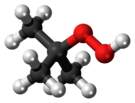Chemistry:Tert-Butyl hydroperoxide
|
| |||
| Names | |||
|---|---|---|---|
| Preferred IUPAC name
2-Methylpropane-2-peroxol[1] | |||
| Systematic IUPAC name
tert-Butyl hydroperoxide | |||
| Identifiers | |||
3D model (JSmol)
|
|||
| Abbreviations | TBHP | ||
| 1098280 | |||
| ChEMBL | |||
| ChemSpider | |||
| EC Number |
| ||
| MeSH | tert-Butylhydroperoxide | ||
PubChem CID
|
|||
| RTECS number |
| ||
| UNII | |||
| UN number | 3109 | ||
| |||
| |||
| Properties | |||
| C4H10O2 | |||
| Molar mass | 90.122 g·mol−1 | ||
| Appearance | Colorless liquid | ||
| Density | 0.935 g/mL | ||
| Melting point | −3 °C (27 °F; 270 K) | ||
| Boiling point | 37 °C (99 °F; 310 K) at 2.0 kPa | ||
| miscible | |||
| log P | 1.23 | ||
| Acidity (pKa) | 12.69 | ||
| Basicity (pKb) | 1.31 | ||
Refractive index (nD)
|
1.3870 | ||
| Thermochemistry | |||
Std enthalpy of
formation (ΔfH⦵298) |
−294±5 kJ/mol | ||
Std enthalpy of
combustion (ΔcH⦵298) |
2.710±0.005 MJ/mol | ||
| Hazards | |||
| Main hazards | oxidizer | ||
| Safety data sheet | [1] | ||
| GHS pictograms |      
| ||
| GHS Signal word | DANGER | ||
| H226, H242, H302, H311, H314, H317, H331, H341, H411 | |||
| P220, P261, P273, P280, P305+351+338, P310 | |||
| NFPA 704 (fire diamond) | |||
| Flash point | 43 °C (109 °F; 316 K) | ||
Except where otherwise noted, data are given for materials in their standard state (at 25 °C [77 °F], 100 kPa). | |||
| Infobox references | |||
tert-Butyl hydroperoxide (tBuOOH) is the organic compound with the formula (CH3)3COOH. It is one of the most widely used hydroperoxides in a variety of oxidation processes, for example the Halcon process.[3] It is normally supplied as a 69–70% aqueous solution. Compared to hydrogen peroxide and organic peracids, tert-butyl hydroperoxide is less reactive and more soluble in organic solvents. Overall, it is renowned for the convenient handling properties of its solutions. Its solutions in organic solvents are highly stable.
Application
Industrially, tert-butyl hydroperoxide is used to prepare propylene oxide. In the Halcon process, molybdenum-based catalysts are used for this reaction:
- (CH3)3COOH + CH2=CHCH3 → (CH3)3COH + CH2OCHCH3
The byproduct t-butanol, which can be dehydrated to isobutene and converted to MTBE.
On a much smaller scale, tert-butyl hydroperoxide is used to produce some fine chemicals by the Sharpless epoxidation.[4]
Synthesis and production
Many synthetic routes are available,[5] e.g. by the auto-oxidation of isobutane.[3]
Safety
tert-butyl hydroperoxide is potentially dangerous, but explosions are rare.[3]
A solution of tert-butyl hydroperoxide and water with a concentration of greater than 90% is forbidden to be shipped according to US Department of Transportation Hazardous Materials Table 49 CFR 172.101.
In some sources it also has an NFPA 704 rating of 4 for health, 4 for flammability, 4 for reactivity and is a potent oxidant,[6] however other sources claim lower ratings of 3-2-2 or 1-4-4.[7][8]
See also
References
- ↑ "IUPAC Complete Draft 2004". http://www.iupac.org/fileadmin/user_upload/publications/recommendations/CompleteDraft.pdf.
- ↑ Cameo Chemicals, reference for NFPA values.
- ↑ 3.0 3.1 3.2 Roger A. Sheldon (1983). Patai, Saul. ed. Syntheses and Uses of Hydroperoxides and Dialkylperoxides. PATAI'S Chemistry of Functional Groups. John Wiley & Sons. doi:10.1002/9780470771730.ch6.
- ↑ tert-butyl hydroperoxide at Organic Chemistry Portal
- ↑ Jose Sanchez; Terry N. Myers. "Peroxides and Peroxide Compounds, Organic Peroxides". Kirk‑Othmer Encyclopedia of Chemical Technology. Wiley-VCH Verlag GmbH & Co.. doi:10.1002/0471238961.1518070119011403.a01.
- ↑ "TERT-BUTYL HYDROPEROXIDE" at CAMEO Chemicals NOAA
- ↑ tert-BUTYL HYDROPEROXIDE at Chemicalland21
- ↑ tert-Butyl hydroperoxide at http://environmentalchemistry.com
 |




